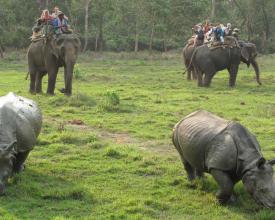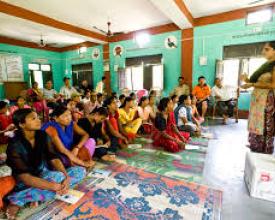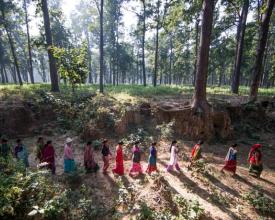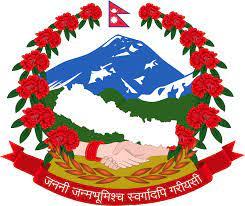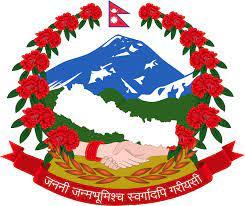
Successfully conserving critical corridors and bottlenecks using the community-based management.

Since the last decade in Nepal, the landscape-based conservation approach has been adopted as an opportunity to scale up conservation initiatives. The Terai Arc Landscape Programme of Nepal is one of the examples of such approach. The implementation has been tailored to the specific requirements of core protected areas, buffer zones, corridors, and bottleneck areas. The approach has resulted in a higher level of biodiversity conservation and management, increased number of all species of megafauna, improved livelihoods of local communities with women leadership, sustainable forest management and ultimately contributed to address climate change. It has distributed the roles, rights and responsibilities among diverse stakeholders, and they are brought together to conserve forests and biodiversity through community-based management (CBM). Dr Ram Prasad Lamsal has contributed significantly to improving policy, practices, and governance and building innovations in CBM in the landscape.
Context
Challenges addressed
Population pressure on forest resources through shifting cultivation, overgrazing, commercial tree cutting, and agricultural land encroachment is leading to severe exploitation of forest resources in Nepal, with seroius ecological consequences in the form of soil erosion and landslides. Climate change along with human activities have led to deforestation, forest and habitat degradation and unsustainable logging. Major threats are grazing all year around, poaching for high value products, illegal logging and unsustainable tourism.
Location
Process
Summary of the process
To ensure the success of CBM and its associated strategies, a set of principles are considered as the building blocks. The principles cannot be thought of as independent building blocks ; they rather can be arranged in a mix and match approach: taking the most desirable option from each block to create an effective, efficient, and equitable conservation which maximises the potential benefits and minimises the risks. Effective participation is an important characteristic of effective governance, and involves identifying multiple stakeholders and incorporating them in decision-making processes. Stakeholders can start interacting with each other through formal and informal rules, institutions and processes.
The laws create rights that provide the foundation for forest institutions and processes. These institutions establish basic principles for how people interact with each other and with their resources. This includes rights to access, stakeholder management and the ability to pass these rights on to future generations.
Building Blocks
Communities empowered and trusted
Conservation oriented community forestry is essentially a participatory process that requires strong technical assistance on both policy and implementation. Expanding the property rights of local communities over resources and empowering them with knowledge, information, resources, technologies, and required skills for forest management and institution building are basic building blocks for the community forestry. Gender and equity concerns are addressed from the program design so that the poor, women, and marginalized receive fair benefits from the program.
Enabling factors
Legal rights over the resources, institutions, capacity, trust, and leadership,
Lesson learned
It evolved from the community level, and is based on traditional uses of the forest by communities. This bottom-up approach is a great strength of the Nepalese model as it gives ownership and leadership to communities to decide both where to create a community forest and how to run it.
Benefits generated to communities and livelihood improved
Community forestry in Nepal has brought a number of benefits including an increase in income. It has helped to fight against illegal logging by putting clear rules in place on timber access and a strong system of forest monitoring. Community livelihoods have also improved with easier access to firewood and fodder and better health care and energy access, for example through money from ecotourism and subsidies for renewable energy.
Enabling factors
Community forestry shows traits of political, financial, and ecological sustainability, including emergence of a strong legal and regulatory framework, and robust civil society institutions and networks.
Lesson learned
A continuing challenge is to ensure equitable distribution of benefits to women and marginalized groups.
The immediate livelihood benefits derived by rural households bolster strong collective action wherein local communities actively and sustainably manage forest resources. Community forests also became the source of diversified investment capital and raw material for new market-oriented livelihoods.
Impacts
The program has yielded the following impacts:
- Forests protected, restored, and managed; conserved biodiversity, wildlife and habitats and wetlands; increased number of all species of megafauna, empowered communities for gender, leadership, livelihood improvement and enterprises; and addressed climate change issues.
- Developed improved community-based model with cost effective approach and high degree of community participation and contribution, and strong partnership.
- Hybridized traditional and scientific knowledge; and shared monitoring, evaluation and learning system.
Beneficiaries
The beneficiaries are socially disadvantaged women, untouchables, indigenous communities, minorities, people with disabilities, marginalized groups, backward classes, youth, farmers, workers, oppressed and economically poor.
Sustainable Development Goals
Story
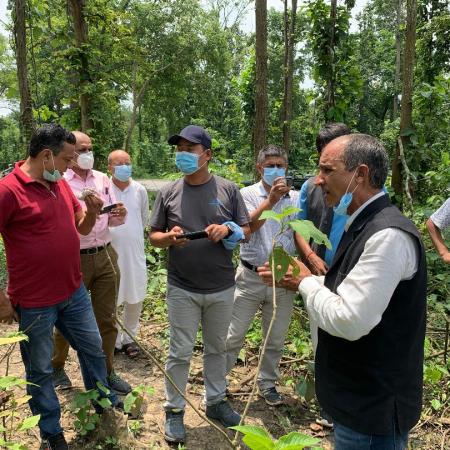
Forest encroachment evacuated by local communities
In the Nepalese context, forest encroachment is the illegal conversion of forested land to other land uses, such as agriculture and settlement. It is one of the major drivers of deforestation and forest degradation in Nepal which is more prominent in the Terai and Siwalik regions.
Just before the local election in 2018, nearly 4000 people from outside the district have come with political motive to encroach the forest land being managed by local communities. The local communities developed the networks, communicated with law enforcement agencies and developed teams to evacuate the encroachers and protect the forest. The communities succeeded and the forest is under active management.


